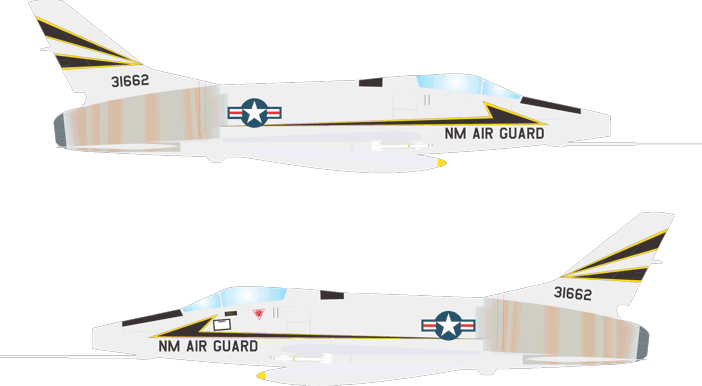
The
accidental shoot down of B-52B 53-0380
 |
It is an unfortunate fact of military life that training can often be as deadly as combat. That is made more tragic when an accident can be prevented from the outset. Such is the case with the accidental shoot down of a B-52 Stratofortress by the New Mexico Air National Guard during 1961.
On April 7, 1961 a B-52B took off from Biggs Air Force Base, at El Paso, Texas on a practice mission. The "BUFF" was given the serial number 53-0380 when she was built and was christened the "Ciudad Juarez" when she was assigned to the 95th Bomb Wing at Biggs. That name was in honor of El Paso's sister city across the Rio Grande. Part of the mission for the day was to provide a "target" for two F-100As piloted by 1st Lt. James W. van Scyoc and Capt. Dale Dodd of the 188th Fighter Interceptor Squadron (NMANG) to practice intercepts on. Little did anyone know how realistic that was to become.
The two Huns that were to make passes on the bomber started their runs at 34,000 feet. As was the common practice in those days, they each carried GAR-8 Sidewinder missiles. The Sidewinder has a "heat seeking" guidance system where the seeker head in the front of the missile will pick up the infra red signature of another aircraft and guide the missile to that heat source. The GAR designation was later changed to AIM-9B. The AIM-9Bs in use that day were live missiles, but had been wired in such a way that only the seeker head was supposed to be active. The two F-100s had made five successful passes (or intercepts). On the sixth pass the B-52 crew heard the gut wrenching words of Lt. van Scyoc: "Look out! One of my missiles is loose!" The Sidewinder flew straight and true and impacted one of the engine pods on the left wing taking the wing off in the explosion. Even with the small charge carried by the missile the bomber was fatally wounded. Capt Donald D. Blodgett described in the February, 1962 issue of Interceptor what happened next: "As the B-52 veered sharply to the left, I applied full right aileron but the aircraft remained in a left bank. The controls were shaking so hard I was unable to get my hand on the inter-phone button to tell the crew to bail out. I let go with my right hand and hit the alarm bell." He then continues to describe his ejection and the breakup of the airplane. Some time after he landed, his tail gunner found him. Later that day a helicopter rescued them, but it was two days later before the copilot and crew chief were located and rescued. Three other crew members perished in the crash, their bodies still inside the wreckage.
Over the years, I have heard two plausible explanations: 1. Moisture in the cannon plug attaching the Sidewinder to the aircraft pylon had completed a circuit causing the missile to launch. and 2: That during construction of the F-100 a wire bundle in the fuselage had been crimped causing a short that completed the firing circuit. (In fact, the F-100A was built without Sidewinder capability.* That was only added when the A models went into ANG service, so the wire bundle explanation is weak.) In either case live missiles became less common over the years, though at least as recently as the mid 1980s a U.S. Navy F-14 shot down a German based USAFE RF-4C in a similar incident. Most practice missions are now flown with a training round that contains an active seeker head, but an inert body. The accident board found that moisture was the cause and most importantly that Lt. van Scyoc was not at fault.
I have often wondered if James van Scyoc suffered from the stress that is often related to an accident beyond one's control. I hope that he is living a happy successful life and that this accident has not haunted him. He retired from the Air National Guard as a Colonel and passed away 6 October, 2014.
A photo of Ciudad Juarez is posted on the B-52 page. Below is a shot of four New Mexico ANG F-100As in flight. In 1964 the 188th FIS would replace the A models with C models and change designations to the 188th TFS. The aircraft in this picture are in natural metal finishes with black and yellow "flashes". |
AIM-9B Sidewinder
The crew of the ill fated B-52 were:
Capt. Donald C. Blodgett
(Aircraft Commander)
Capt. Ray C.
Obel (Co-pilot)
Capt. Peter J.
Gineris (Navigator)
Capt. Stephen
Carter (Bombardier)
Capt. George D.
Jackson (ECM)
2nd Lt. Glenn
Bair (ECM Student)
S/Sgt. Ray A.
Singleton (Gunner)
S/Sgt. Manuel L.
Mieras (Maintenance Controller)
Captains Gineris and Carter and Lt. Bair lost their lives in the accident. The survivors all suffered injuries with Sergeant Mierea losing his legs.
Since writing the above account in 2002, I have learned that the F-100A (53-1662**) that launched the missile was flown by 1st Lt. James W. van Scyoc. The second Hun was piloted by Capt. Dale Dodd.
Here is a link that adds
some details to the accident: Casualties of the Cold War
This personal
perspective should help to provide a human element to two of
the tragedies that occurred during the B-52 years:
* The GAR-8 Sidewinder was tested on F-100s at NAS
China Lake in October, 1957. The F-100 did not carry them
until sometime in 1958.
**F-100A
53-1662 was later converted to an F-100A-rehab for
Taiwan. The conversion included an F-100D tail and
inflight refueling capability.
An F-100A-rehab
displayed at Hsinchu Air Base, Taiwan. (Wikimedia)
 |
My guestbook is on the main page.